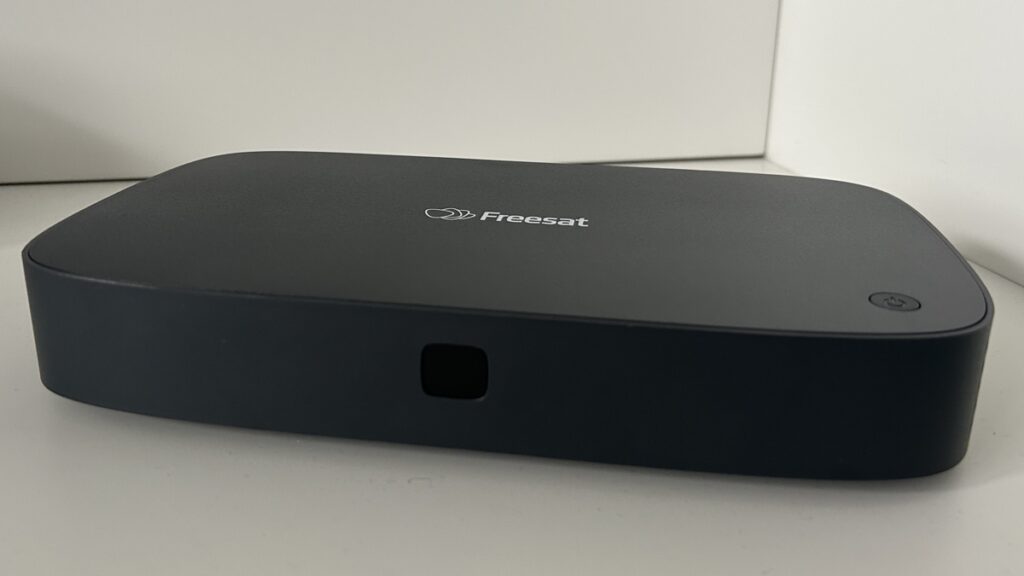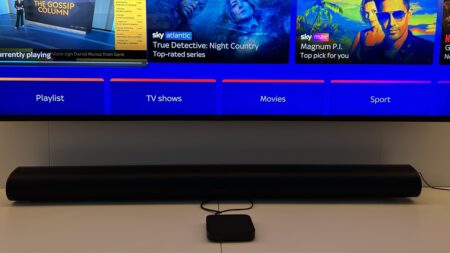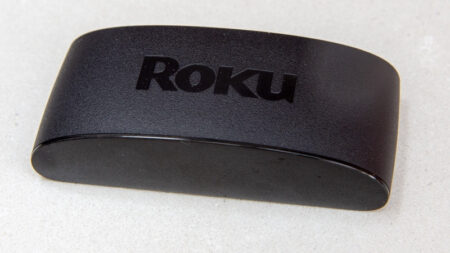The Freesat Recordable 4K TV Box makes the satellite dish on the side of your house useful again if you've ditched subscription-TV with Sky, but it's quite a pricy, clunky affair and you might be better suited just getting a much slicker streaming box or stick if you're mainly interested in on-demand 4K apps. There are no 4K broadcast channels in the UK at present and, while the Freesat box offers crisp HD live TV from your dish, there are also plenty of TVs that now offer this too, without the need for an extra device.
Pros
- Works with your old Sky dish
- No subscription fees
- 4K streaming from apps
- Lots of free HD channels
Cons
- No 4K broadcasting
- Initial signal issues
- Major apps missing
- Expensive
- Horrible, IR-only, remote control

Freesat Recordable 4K TV Box: Introduction
Recently, I made the jump to Sky Stream and essentially dished the dish. Except I didn’t. When you get rid of the ‘old’ Sky setup, nobody comes to take down your satellite dish, nor gets rid of the coaxial cables that deliver the signals from the dish to your set-top box.
So you’re effectively left with some useless equipment and cabling. Or are you?
Freesat is a subscription-free satellite television service available in the United Kingdom that offers a range of free-to-air digital television and radio channels using a satellite dish.
Like Freeview (which is part of the same Everyone TV company), Freesat is backed by the likes of the BBC, ITV, Channel 4 and Channel 5, and offers an alternative to traditional cable and satellite TV subscriptions, giving viewers a selection of channels without ongoing costs beyond the initial equipment setup.
That equipment, for this review, is the Freesat Recordable 4K TV Box. As you may have guessed from the name, it’s a set-top box with PVR capabilities, which is also built with 4K streaming in mind.
So if you’re looking to make the switch to Sky Stream or just want to get rid of your Sky subscription and you have a dish and cables already in place, read for my Freesat Recordable 4K TV Box review to see if it may be the device for you.
Design and installation
- 500GB, 1TB and 2TB versions
- Multi LNB support – can record four shows at once
- 4K streaming apps on offer
There are actually a number of Freesat boxes to choose from, including a smaller version than the one I have on test here, which offers no-recording capabilities but lets you watch live TV and use the apps.
The Recordable variants come in three storage sizes: 500GB (£199.99, 125 hours of HD), 1TB (£229.99, 250 hours of HD) and 2TB (£269.99, 500 hours of HD)… I’ve got the 500GB on test for this review.
That’s pretty pricey, and it’s actually a price that hasn’t dropped in the 3+ years that these boxes have been available.
Yes, they trump the streaming-only devices such as Apple TV and Fire TV by letting you watch and record live TV but, given most of the major terrestrial broadcasters now offer apps where both live(ish) TV and almost-immediate catch up are on offer, it’s up to you whether the more expensive outlay is worth it.
Freesat has done a pretty good job with the design. Measuring just 250 x 150 x 35 mm, it’s much smaller than a Sky+ box and quite a bit slender than a Sky Q set top box too.
The box features gentle curves with the clean front home to just the IR receiver, with a solitary power button on the top-right corner.
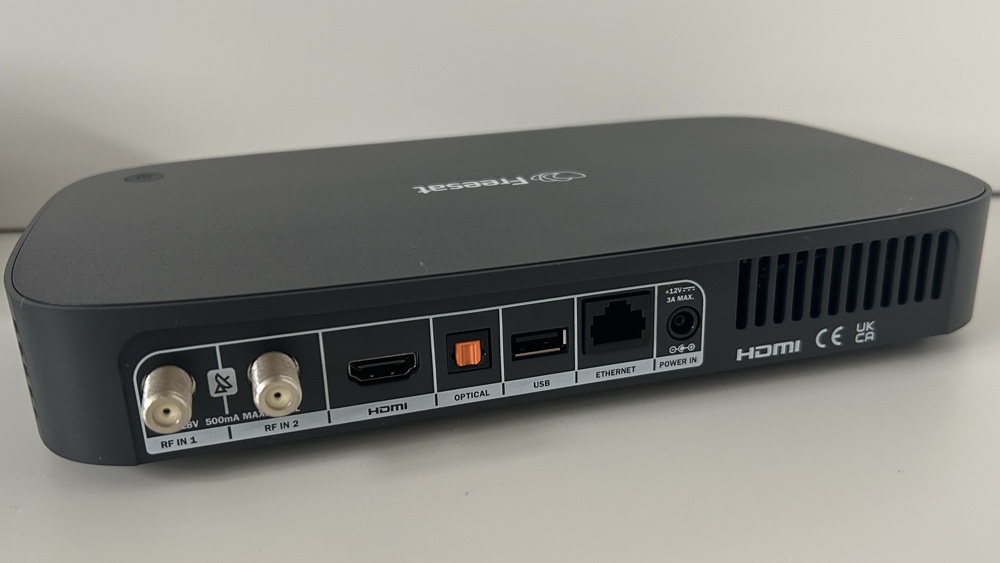
On the back you’ll find a HDMI 2.0 (HDCP 2.2) output with support for Dolby Atmos, an Optical S/PDIF for soundbars and AV receivers and a pair of F-connectors.
These RF1 and RF2 inputs are where the coaxial cable from your satellite dish screw in, in exactly the same way as they did on your Sky box.

Their functionality depends on the type of Low Noise Block (LNB) installed on your satellite dish, however.
With standard LNBs, users can record two channels simultaneously. However, wideband LNBs expand this capability, allowing for the recording of up to four channels at the same time. If you’re switching over from Sky Q, chances are you’ll have a wideband LNB (WLNB) in place.
You’ll also find an Ethernet port, which you can use to stream the apps, if you don’t want to use the box’s dual-band Wi-Fi 802.11n.
During setup you add the box to your home Wi-Fi, and add your postcode so as the localised versions of certain TV channels are presented correctly.
Then it does a signal test, which I presumed would be pretty quick but failed and cased me a delay in completing the set-up process for a few hours.
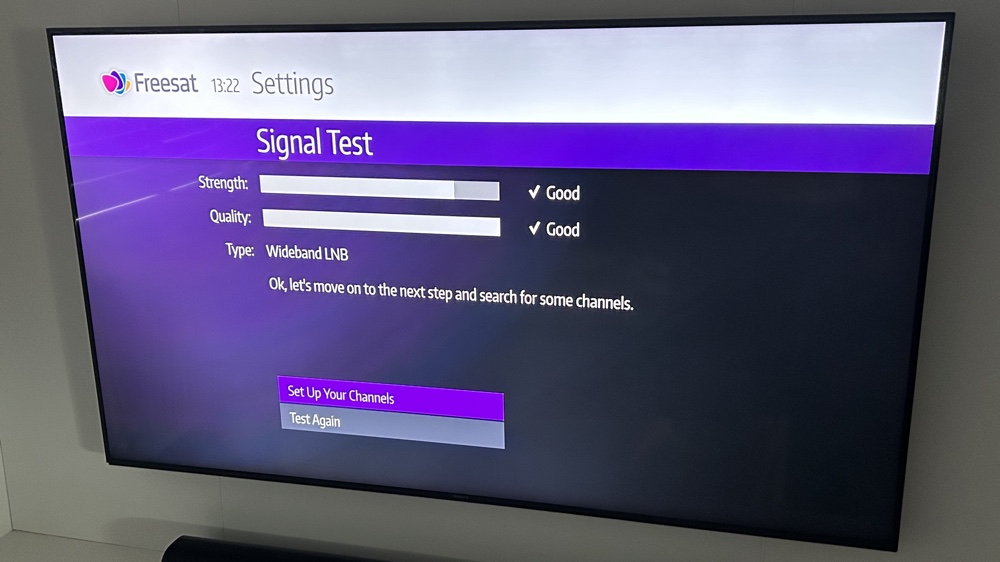
A quick Google of my issue – i.e. no signal being detected – indicated that it was a widespread issue, related to certain WNLBs and that time was the only healer. Effectively, I had to leave the box powered on overnight to perform a software update that sorted the issue.
Once you’ve overcome any signal problems, all of your available live channels are populated and you are good to go.
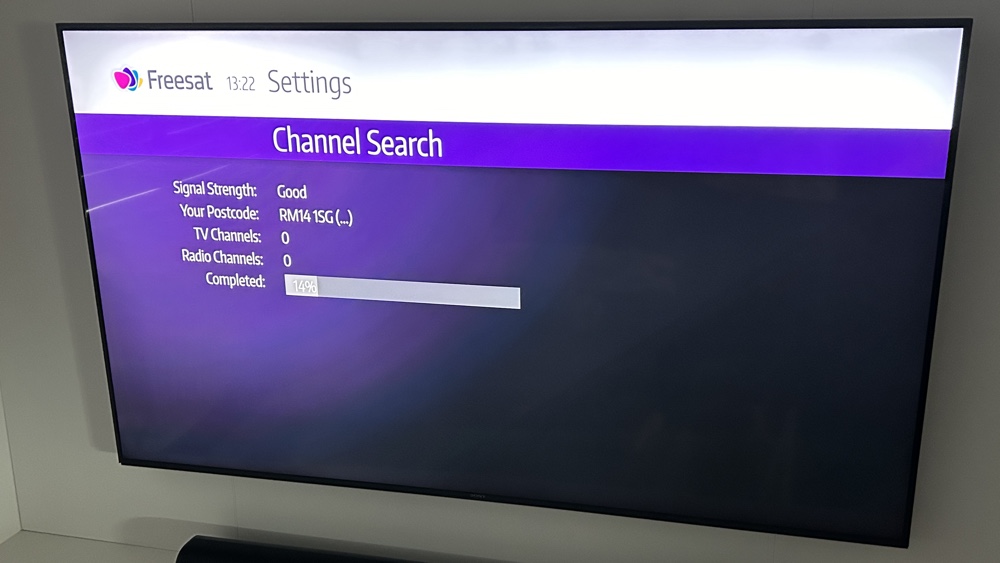
The ergonomic remote is pretty ugly and very clicky, and feels like a controller from the early 2000s. It’s not the slick, svelte controllers we’re more used to nowadays.

It’s also just IR, not Bluetooth, so you will need the box in sight to control it. You can, apparently, register for a Freesat account and control the box using an app but I couldn’t actually manage to login, nor sync things up; it just kept throwing me round in a loop so I gave up in the end.
In use
- 7-day scrollback on offer
- Easy to use UI
- 180+ channels
As mentioned above, it’s a lot smaller than your ancient Sky+ box, and smaller than the more recent Sky Q boxes too and the good news is that it’s also quieter and doesn’t get as hot.
Emphasising simplicity, the main menu offers a concise selection of options, allowing quick navigation to the TV guide, your recordings, on-demand apps, and settings.

The on-demand button is strangely named, it just throws you to a menu screen with all the apps available to you. It’d probably have made more sense to use this button to let people access recordings.
Similar to Freeview, Freesat incorporates a scrollback feature in the Guide, enabling users to backtrack up to seven days.

If a missed program is available on-demand, users can swiftly select it and transition to the corresponding on-demand app.
Certain shows on the BBC offer the option to start from the beginning via the iPlayer.
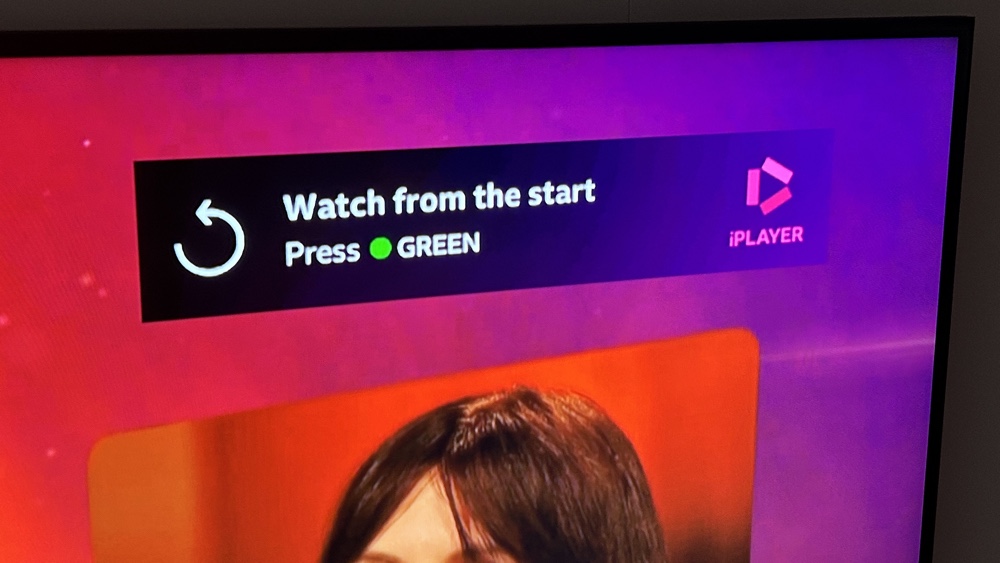
In the Guide, users can easily schedule recordings by pressing the designated button on the remote, with options to record single episodes or entire series.
While watching a program, users can initiate recording, albeit with an intrusive full-screen dialog prompt. Additionally, Live TV can be paused for added convenience.
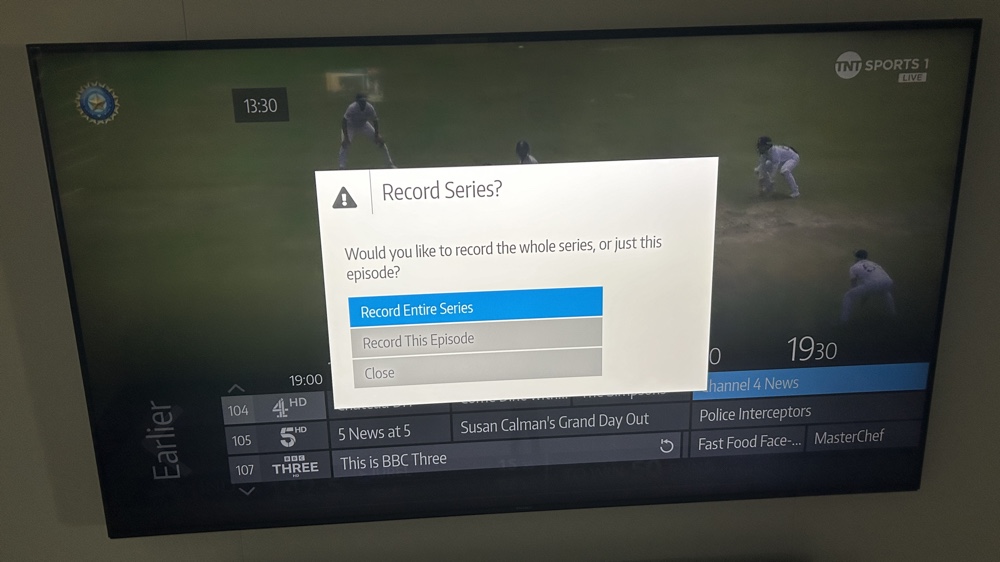
With over 180 channels, including 25+ in HD, featuring popular broadcasters such as the BBC, ITV, and Channel 5, the channel lineup offers a diverse range of content.
However, the 4K in the name doesn’t refer to broadcast at all (although it does upscale all content to a 2160p output). There are currently no 4K free broadcasts in the UK which, in 2024, seems bonkers.
For 4K action (HDR, not Dolby Vision) you’ll have to fire up the likes of Netflix, Amazon Prime or YouTube.

I couldn’t seem to access any UHD content at all on the device’s iPlayer app which seems odd. Presumably things like the World Cup and Wimbledon will have a 4K option but shows such as Boarders and The Tourist not presenting 4K options on the Freesat box, when I can access them in 4K on other streaming devices plugged into the same TV.
When you do stream 4K, from the likes of Netflix, the visuals are impressive. It’s not quite on-par with Apple TV or my Sky Stream puck but it’s certainly a vast improvement over Full HD 1080p.
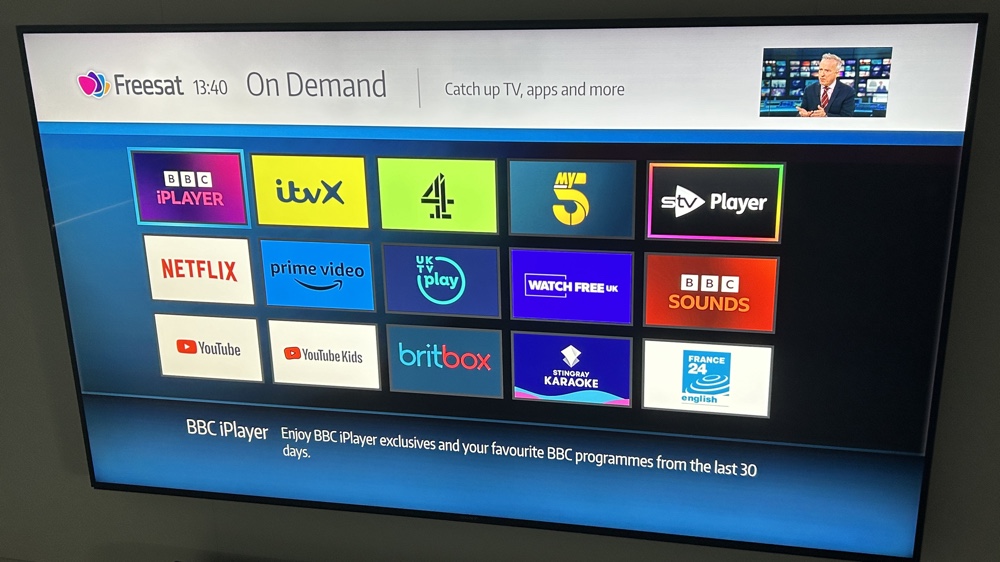
There are a number of apps on offer, and the likes of the iPlayer and Netflix let you use QR code for easy login from your phone but notably there’s no no Apple TV, no Disney+, no Discovery+ or Paramount Plus.
Back to broadcasting and the regular HD picture quality is pretty decent, around the same level that I was getting with Sky Q. However, the compulsory upscaling makes SD channels looks terrible, so stay away from those if you can.
Recordings are almost impossible to distinguish from their broadcast counterparts, there’s no pixelation or anything that deteriorates, to my eye at least, from the original.

Dolby Atmos hit and miss, and only available through streaming. Sometimes it seems to work, sometimes it doesn’t.
The search option is also a bit temperamental, and it doesn’t seem to pick up shows or movies from apps, just results from the linear TV channels in the TV guide.
Final thoughts
If you’re looking for a Freesat box with recording capabilities then this 4K box is probably your best bet. But do you really need it? Will a regular streaming stick not do the job if you’re not after premium channels? Lot’s of TVs also offer Freesat tuners now, so make sure you shop around first.
How we test
When we publish our reviews, you can rest assured that they are the result of “living with” long term tests.
Because we’re testing devices all day, everyday, we know what matters and how a particular gadget compares to alternatives that you might also be considering.
Our reviews are comprehensive, objective and fair and, of course, we are never paid directly to review a device.
Read our guide on how we test to learn more.
FAQs
No, there are only 4K visuals through apps like Netflix and Amazon Prime.
No, it’s UHD HDR on offer.
They are part of the same company – Everyone TV – but, while both services aim to provide access to free television channels, they use different technologies; satellite dishes for Freesat and terrestrial aerials for Freeview.


